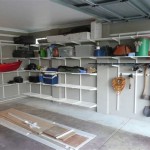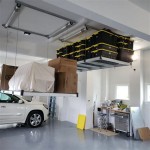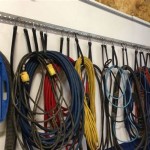How To Set Up A Home Gym In Your Garage
Transforming a garage into a functional home gym requires careful planning and execution. This endeavor offers the convenience of personalized fitness within the familiar environment of one's home. However, its success hinges on thoughtful consideration of space, equipment, and safety. The subsequent sections outline the necessary steps to create a well-equipped and effective garage gym.
Assessing and Preparing the Garage Space
The initial step involves a thorough assessment of the existing garage space. This includes measuring the dimensions of the garage to determine the available square footage. Careful attention should be paid to the ceiling height, as this will influence the type of equipment that can be accommodated, particularly for exercises that involve overhead movements like pull-ups or Olympic weightlifting.
Following the measurement phase, a comprehensive cleaning process is essential. This entails removing all existing items from the garage to provide a clear workspace and to accurately evaluate the condition of the floor. Sweeping, vacuuming, and potentially power washing the floor are crucial steps to eliminate dust, debris, and any potential contaminants. The cleanliness of the space directly impacts air quality and contributes to a safer, more hygienic workout environment.
Floor preparation is critical for both safety and equipment preservation. Garage floors are typically made of concrete, which can be cold, hard, and unforgiving. Installing a suitable flooring option can significantly improve the workout experience. Options include rubber flooring, interlocking foam tiles, or a rolled rubber mat. Rubber flooring is particularly advantageous as it provides cushioning, absorbs impact, and protects the concrete floor from damage caused by dropped weights. The thickness of the flooring should be considered based on the intended use; heavier weightlifting activities necessitate thicker flooring.
Adequate ventilation is paramount for a comfortable and safe workout environment. Garages are often poorly ventilated, leading to stuffiness and the potential build-up of unpleasant odors. If the garage lacks sufficient natural ventilation, consider installing a ventilation system or a high-powered fan. A ceiling fan can circulate air effectively, while an exhaust fan can remove stale air and improve air quality. Proper ventilation helps regulate temperature, reduces humidity, and provides a more enjoyable workout experience.
Finally, evaluate the existing lighting situation. Garages often have inadequate lighting, which can create a dimly lit and potentially hazardous environment. Upgrading the lighting system is essential to ensure sufficient visibility during workouts. Options include installing brighter overhead lights, such as LED shop lights, or adding supplemental lighting in specific areas of the gym. Proper lighting enhances safety, improves visibility, and creates a more motivating workout environment.
Selecting and Acquiring Appropriate Equipment
Choosing the right equipment is crucial for achieving fitness goals and ensuring a safe and effective workout experience. The selection process should be guided by individual fitness objectives, available space, and budget constraints. It is important to prioritize equipment that aligns with intended workout routines and that can be safely accommodated within the garage space.
For individuals interested in strength training, a power rack or squat stand is a fundamental piece of equipment. This allows for a wide range of exercises, including squats, bench presses, and overhead presses. A good quality power rack should be sturdy and capable of supporting significant weight. Safety features, such as safety pins or spotter arms, are essential to prevent injuries during heavy lifts. Consider the dimensions of the power rack to ensure it fits comfortably within the garage space and allows for adequate clearance around the equipment.
Dumbbells and weight plates are versatile tools that can be used for a variety of exercises. A set of adjustable dumbbells offers flexibility and allows for progressive overload. Weight plates can be used with a barbell or for exercises like plate raises and weighted squats. When selecting weight plates, consider the material and construction. Bumper plates are particularly suitable for Olympic weightlifting, as they are designed to be dropped without damaging the floor or equipment. Cast iron plates are a more cost-effective option for general strength training.
Cardiovascular equipment is important for improving cardiovascular health and burning calories. Options include a treadmill, elliptical, stationary bike, or rowing machine. The choice of cardiovascular equipment depends on individual preferences and fitness goals. Consider the size and features of each piece of equipment before making a purchase. A treadmill offers a versatile workout option, but it requires significant space. An elliptical provides a low-impact workout that is gentle on the joints. A stationary bike is a compact and efficient way to improve cardiovascular fitness. A rowing machine engages multiple muscle groups and provides a full-body workout.
A weight bench is essential for performing exercises like bench presses, dumbbell rows, and tricep dips. A good quality weight bench should be sturdy and adjustable. An adjustable bench allows for performing exercises at different angles, which can target different muscle groups. Consider the weight capacity of the bench to ensure it can safely support the user's weight and the weight being lifted.
Finally, consider the addition of smaller accessories to enhance the workout experience and expand the range of exercises that can be performed. These accessories may include resistance bands, jump ropes, medicine balls, and foam rollers. Resistance bands are versatile and can be used for a variety of exercises, including warm-ups, stretching, and strength training. Jump ropes are an effective way to improve cardiovascular fitness and coordination. Medicine balls can be used for core training and explosive movements. Foam rollers are essential for improving flexibility and reducing muscle soreness.
Organizing and Maintaining the Garage Gym
Effective organization is paramount for maximizing the functionality and safety of a garage gym. A well-organized gym allows for efficient workouts, minimizes the risk of injuries, and creates a more inviting and motivating environment. Implementing a system for storing equipment and supplies is essential for maintaining order and preventing clutter.
Investing in storage solutions is crucial for keeping the gym organized. Options include shelving units, racks, and wall-mounted organizers. Shelving units can be used to store smaller items, such as dumbbells, resistance bands, and medicine balls. Racks are ideal for storing weight plates and barbells. Wall-mounted organizers can be used to store items like yoga mats and foam rollers. The choice of storage solutions depends on the available space and the types of equipment being stored. Consider the weight capacity of the storage solutions to ensure they can safely support the weight of the equipment.
Designating specific areas for different types of exercises can help to improve workflow and prevent clutter. For example, a designated area for weightlifting, a separate area for cardiovascular exercises, and a dedicated area for stretching and flexibility work. Clear demarcation of these zones helps streamline the workout process and ensures that equipment is readily available when needed. This approach also minimizes the risk of tripping or bumping into equipment during workouts.
Regular cleaning and maintenance are essential for maintaining a safe and hygienic workout environment. Wipe down equipment after each use to remove sweat and prevent the build-up of bacteria. Sweep or vacuum the floor regularly to remove dust and debris. Inspect equipment regularly for signs of wear and tear. Replace worn or damaged parts promptly to prevent injuries. Proper maintenance ensures that the equipment remains in good working condition and extends its lifespan.
Implementing safety protocols is paramount for preventing injuries. Ensure that there is adequate space around equipment to allow for safe movement. Use proper lifting techniques to avoid strains and sprains. Always use spotters when lifting heavy weights. Store weight plates and barbells securely to prevent them from falling. Keep a first-aid kit readily available in case of minor injuries. Familiarize oneself with the proper use of all equipment before beginning a workout. Adhering to these safety protocols minimizes the risk of injuries and ensures a safe and effective workout experience.
Personalizing the gym with motivational elements can enhance the workout experience and create a more inspiring environment. Add mirrors to monitor form and technique. Display motivational posters or artwork. Play music that energizes and motivates. Incorporate plants or other natural elements to create a more welcoming atmosphere. Personalizing the gym to reflect individual preferences and goals can help to increase motivation and adherence to a regular workout routine.

Creating A Home Gym In Your Garage Premiergarage

How To Create A Fitness Garage Gym In Your Home Schroeder Design Build

How To Create A Home Gym In Your Garage Pinnacle Hardware

Creative Diy Garage Gym Ideas To Maximize Your Space Trusscore

Transforming An Empty Garage Into My Home Gym Setup

How To Build The Perfect Home Gym In A Small Garage Budget Friendly Strength Resurgence

Creating A Home Gym In Your Garage Premiergarage

Set Up A Home Gym In Your Garage Musclesquad

So You Want To Build A Home Gym

Creating A Home Gym Buy Equipment Aperformance
Related Posts








